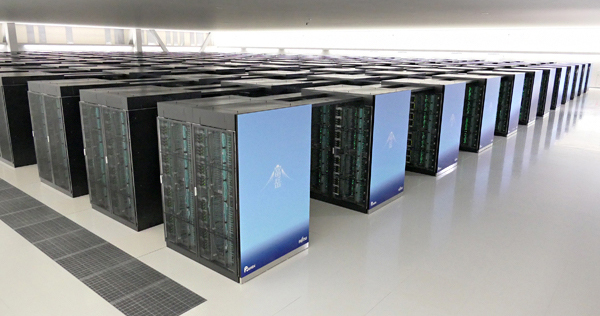Ranking results of HPCG supercomputer ‘Fugaku’ | RIKEN

November 15, 2022
RIKEN
Fujitsu Limited
-Demonstration of comprehensive world-leading performance as HPC infrastructure for realizing Society 5.0-
Developed jointly by RIKEN (Riken) and Fujitsu Limited (Fujitsu) and started sharing from March 2021Supercomputer “Fugaku”[1]is a performance ranking of supercomputers in the world, and is often used in actual applications such as industrial use.conjugate gradient method[2]For the 6th consecutive year, it was ranked No. 1 in the world for the processing speed of HPCG (High Performance Conjugate Gradient).
In the TOP500, “Frontier” (U.S.A.) ranked first and “Fugaku” ranked second. In addition, in the performance benchmark “HPL-AI” for single-precision and half-precision arithmetic processing, which is mainly used in deep learning of artificial intelligence (AI), “Frontier” (USA) ranked first and “Fugaku” ranked third. did.
These rankings were announced in November at SC22, an international conference on HPC (High Performance Computing) currently being held at the Kay Bailey Hutchison Convention Center Dallas in Dallas, Texas, USA and online. It was announced on the 14th (November 15th Japan time).
The 1st place in HPCG for the sixth consecutive term, the 2nd place in the TOP500, and the 3rd place in HPL-AI continue to demonstrate Fugaku’s world-leading overall performance. Aiming to realize a super smart society that creates new valueSociety 5.0[3]In , we will demonstrate that Fugaku can fully demonstrate the role of HPC infrastructure for solving social issues by simulation, developing AI, and accelerating technological development related to information distribution and processing.

Supercomputer “Fugaku”
“Fugaku” measurement result
HPCG
For the HPCG measurements, 432 cabinets of Fugaku (158,976node[4]), it achieved a high benchmark score of 16.00 PFLOPS (petaflops), and this time, “Fugaku” won the world’s No. 1 ranking for the sixth consecutive term. This result proves that “Fugaku” efficiently processes actual applications such as industrial use and exhibits high performance.
As of November 2022, the second place in the ranking of “HPCG” is “Frontier” in the United States, with a measurement result of 14.05 PFLOPS. In other words, this time, “Fugaku” has a performance difference of about 1.1 times over the second place.
Related Links:
TOP500
The “Fugaku” system registered in the “TOP500” list has a configuration of 432 units (158,976 nodes), and the LINPACK performance, which is a ranking index, is 442.01 PFLOPS (petaflops), and the execution efficiency is 82.3%, which is the second highest in the world. did.
As of November 2022, the world’s top ranking in the “TOP500” list is “Frontier” in the United States, with a measurement result of 1,102 PFLOPS.
Related Links:
HPL-AI
Unlike “TOP500” and “HPCG”, which measure the performance of double-precision arithmetic units, “HPL-AI” is a calculation that takes into account the abilities of single-precision and half-precision arithmetic units used in AI calculations. A benchmark established in November 2019 as an index for evaluating performance. For this measurement, 432 cabinets (158,976 nodes) of “Fugaku” were used, and a score of 2.004 EFLOPS (exaflops) was recorded, ranking third in the world.
As of November 2022, the top HPL-AI ranking is Frontier in the United States, with a measurement result of 7.9 EFLOPS.
Related Links:
About supercomputer ranking
HPCG
“TOP500” is an important performance index for solving simultaneous linear equations composed of dense coefficient matrices, and has long been popular as a benchmark mainly for evaluating computing power. However, more than 20 years have passed since the project was launched in 1993, and in recent years it has been pointed out that there is a gap between the performance requirements of actual applications and the length of time required for benchmark tests.
Therefore, Dr. Jack Dongarra et al. developed a new benchmark program “HPCG” using the conjugate gradient method, which is a computational method for solving simultaneous linear equations composed of sparse coefficient matrices, which is often used in practical applications such as industrial use. ” was proposed. After announcing measurement results of 15 major supercomputer systems in the world at ISC14 in June 2014, the official ranking was announced at SC14, an international conference on HPC held in New Orleans, USA in November of the same year.
TOP500
The “TOP500” list is a project that regularly ranks and evaluates the top 500 fastest computer systems in the world, using LINPACK execution performance as an index. Launched in 1993, it publishes supercomputer rankings twice a year (June and November).
LINPACK is a program for solving simultaneous linear equations using matrix calculations developed by Dr. Jack Dongarra of the University of Tennessee in the United States. We determine the calculation speed ranking of computers by measuring the arithmetic performance of double precision floating point numbers used in many scientific calculations and industrial applications. In order to obtain a high score in this benchmark, it is necessary to measure a large-scale benchmark for a long time. Therefore, it is commonly said that a high LINPACK score is an overall indication of computational power and reliability.
HPL-AI
“TOP500” and “HPCG” have been ranked by the computational performance of solving simultaneous linear equations. In both cases, the rules stipulated that only double-precision arithmetic (16-digit floating-point numbers in decimal notation), which has been widely used in scientific and industrial calculations, should be used for calculations. In recent years, there have been many high-performance computers equipped with processors for low-precision arithmetic (5 or 10 digits in decimal notation), which are dedicated chips for GPUs and artificial intelligence. There is a fact that these high-performance computing capabilities are not reflected in the “TOP500”, and a new benchmark “HPL-AI”, which has improved the LINPACK benchmark led by Dr. Jack Dongara and allowed to solve with low-precision arithmetic, was released in 2019. proposed in November. “HPL-AI” is LINPACK’s system of linear equations.LU decomposition[5]It is allowed to perform with low precision calculation when solving using .However, since the calculation accuracy is inferior to double precision calculation, we continue to useiterative improvement[6]We are seeking to make the accuracy equivalent to double precision calculation with a technique called. In other words, it is a benchmark consisting of a two-step computational process.
Benchmark program for HPL-AIwas developed by the RIKEN Center for Computational Sciences (R-CCS) according to the ranking rules and is open sourced and published.
Related Links:
supplementary explanation
- 1.Supercomputer “Fugaku”
Successor to the K computer. In the 2020s, we aim to contribute to the growth of Japan by solving social and scientific issues and produce world-leading results. In March 2021, shared use began as a supercomputer of the world’s highest level in terms of the comprehensive power of the creation of results and the acceleration function of big data and AI.
Currently, “Fugaku” is used as an essential HPC infrastructure to realize Japan’s goal of Society 5.0. - 2.conjugate gradient method
Computer simulations of physical phenomena are often solved as large-scale simultaneous linear equations. There are two methods for solving simultaneous linear equations: the direct method, which directly obtains the solution, and the iterative method, which converges to the correct solution by performing iterative calculations. The conjugate gradient method is one of the latter iterative methods, and can quickly converge to a correct solution by combining preprocessing. It is widely used in the computer simulation world. - 3.Society 5.0
It refers to a new society following hunting society (Society 1.0), agricultural society (Society 2.0), industrial society (Society 3.0), and information society (Society 4.0), which Japan should aim for in the 5th Science and Technology Basic Plan. It was proposed for the first time as a form of future society. We will incorporate new technologies that have an impact on society, such as IoT (Internet of Things), robots, AI (artificial intelligence), and big data, into all industries and social life, and achieve both economic development and the resolution of social issues. We aim to realize a new society. - Four.node
The smallest unit of computational resources in which an operating system in a supercomputer can operate. In the case of “Fugaku”, it consists of one CPU (Central Processing Unit) and 32GiB of memory. - Five.LU decomposition
One of the methods for solving simultaneous linear equations. Since the matrix is decomposed into the product of a lower-triangular matrix and an upper-triangular matrix during the solution process, it is called the LU decomposition method. - 6.iterative improvement
Approximate solutions obtained by solving simultaneous linear equations by methods such as LU decomposition contain errors from true solutions. A method of resolving the system of linear equations using the error and correcting the approximate solution to obtain an answer closer to the true solution.
Institution window
Computational Science Research Promotion Office, RIKEN Kobe Office
Public Relations Group Akihiko Okada
Computational Science Research Promotion Office, RIKEN Kobe Office Inquiry Form
RIKEN Public Relations Office
RIKEN Public Relations Office Inquiry Form
Fujitsu Limited
Public Relations & Investor Relations Office
Tel: 03-6252-2174 (Direct)
Supercomputer “Fugaku” (Fujitsu public page)
※above[at]Please replace with @.
